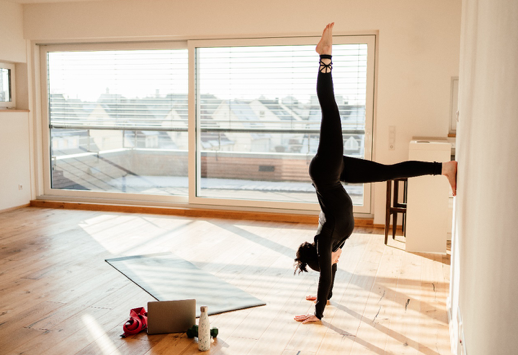With the start of the new year, fitness enthusiasts are embracing the latest workout craze known as wall Pilates. This convenient and enjoyable exercise can easily be done in the comfort of your own home.
Wall Pilates is becoming a hit due to its inclusivity. According to the New York Post, the hashtag #WallPilates has gained significant traction on TikTok, showcasing people opting for these simplified workouts over intense regimens and expensive classes.
Wall Pilates is exactly what it sounds like, Pilates performed up against a wall, which replaces the foot bar used in traditional Pilates classes – Getty Images/iStockphoto
“It’s all about getting back to the basics,” explains Wes Santos, the founder of Instate Fitness, in an interview with The Standard.
But what exactly is wall Pilates? In essence, it involves performing Pilates routines with the support of a wall, replacing the traditional foot bar typically used in classes.
Pilates, established a century ago by Joseph Pilates, has grown popular, especially among women, for its focus on gentle yet effective exercises that improve strength, flexibility, and mental well-being.

Wall Pilates is exactly what it sounds like, Pilates performed up against a wall, which replaces the foot bar used in traditional Pilates classes – Getty Images/iStockphoto
“Wall Pilates is particularly beneficial for beginners,” notes Macallum Livock, a physical therapist at PureGym. “The wall offers stability, allowing novices to feel more confident with their movements while receiving additional support compared to just relying on their body weight.”
Originally intended for rehabilitating soldiers and assisting dancers in toning their bodies and alleviating discomfort, Pilates continues to be favored for physical therapy today.
The isometric nature of Pilates contributes to muscle strengthening without placing excess strain on the joints. Heather A. Milton, an exercise physiologist at NYU Langone Health’s Sports Performance Center, explains, “Gravity serves as the primary resistance in Pilates. Utilizing a wall for static resistance enables individuals to exert force efficiently.”

Pilates has become a widely popular, full-body exercise method, particularly among women who prefer low-impact workouts that focus on improving strength and flexibility. At the same time, research has shown it also soothes mental stress. Getty Images/iStockphoto
Utilizing a wall during Pilates sessions helps individuals stabilize themselves, promoting proper form and alignment while targeting specific muscle groups. It also adds resistance, enhancing the muscle-building process.
“Wall Pilates enhances stability, balance, strength, and control,” states Callie Jardine, the founder of Sweaty Studio, to Today.com. “Unlike traditional Pilates, where your feet are on the ground, elevating your feet can have additional benefits such as improving circulation, aiding digestion, enhancing sleep, and reducing muscle cramps.”
The abundance of online tutorials showcasing wall Pilates exercises has made it more accessible, enabling those hesitant to join public classes to start their fitness journey at home.
However, there are certain drawbacks to practicing alone. “The downside of doing wall Pilates, or any type of Pilates at home without supervision, is the lack of feedback or guidance from an instructor,” warns Korin Nolan, the founder of Power Pilates, in an interview with Women’s Health.
Nolan stresses the importance of maintaining correct posture, performing precise movements, breathing properly, and engaging the correct muscles to optimize the benefits. Beginners may



